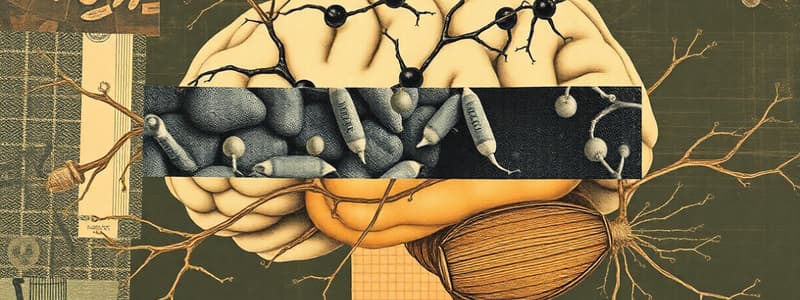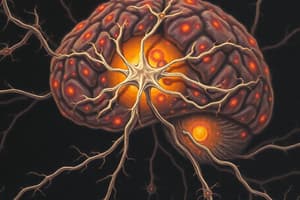Podcast
Questions and Answers
What is the primary function of neurons?
What is the primary function of neurons?
- To transmit electrical signals (correct)
- To produce energy for the body
- To synthesize hormones
- To connect different organs
Which part of the neuron carries impulses away from the cell body?
Which part of the neuron carries impulses away from the cell body?
- Synapses
- Cell body
- Dendrites
- Axons (correct)
What structure wraps around nerve fibers to form the myelin sheath?
What structure wraps around nerve fibers to form the myelin sheath?
- Neuroses
- Dendrites
- Mitochondria
- Schwann cells (correct)
What is the significance of the nodes of Ranvier?
What is the significance of the nodes of Ranvier?
Which factor generally increases the speed of nerve impulse transmission?
Which factor generally increases the speed of nerve impulse transmission?
Why do invertebrate animals often have slower nerve impulses?
Why do invertebrate animals often have slower nerve impulses?
What are relay or connector neurons also known as?
What are relay or connector neurons also known as?
What is the primary function of the sodium/potassium pump in axons?
What is the primary function of the sodium/potassium pump in axons?
What occurs during depolarization of a neuron?
What occurs during depolarization of a neuron?
What is the resting potential typically measured at in a neuron?
What is the resting potential typically measured at in a neuron?
How does the axon membrane respond to a stimulus?
How does the axon membrane respond to a stimulus?
What is the potential difference across the membrane during an action potential?
What is the potential difference across the membrane during an action potential?
What effect does the myelin sheath have on nerve impulse transmission?
What effect does the myelin sheath have on nerve impulse transmission?
Which type of neurones are responsible for controlling voluntary muscle movement?
Which type of neurones are responsible for controlling voluntary muscle movement?
What is the primary contribution of Hodgkin and Huxley's research on squid axons?
What is the primary contribution of Hodgkin and Huxley's research on squid axons?
What is the main function of the Schwann cell in the nervous system?
What is the main function of the Schwann cell in the nervous system?
Which structures are involved in the rapid conduction of nerve impulses due to the myelin sheath?
Which structures are involved in the rapid conduction of nerve impulses due to the myelin sheath?
What happens to the membrane permeability during a nerve impulse?
What happens to the membrane permeability during a nerve impulse?
What is defined as the 'resting potential' in a nerve fibre?
What is defined as the 'resting potential' in a nerve fibre?
Which nervous system structure processes incoming information?
Which nervous system structure processes incoming information?
Which type of nerve fibre is most difficult to access for recordings?
Which type of nerve fibre is most difficult to access for recordings?
What primarily differentiates the ionic concentrations outside and inside an axon at rest?
What primarily differentiates the ionic concentrations outside and inside an axon at rest?
Study Notes
Neurons Basics
- Neurons are specialized cells responsible for transmitting electrical signals, known as nerve impulses.
- They consist of a cell body, containing organelles like the nucleus, mitochondria, rough ER, and ribosomes for neurotransmitter synthesis.
- Dendrites are thin extensions from the cell body that connect with neighboring neurons.
Types of Neurons
- Motor neurons have axons that carry impulses away from the cell body.
- Sensory neurons possess dendrons, which transmit impulses towards the cell body.
- Interneurons or bipolar neurons connect motor and sensory neurons within the CNS.
Myelin Sheath
- Schwann cells wrap around nerve fibers to form a myelin sheath, which has two primary functions:
- Protects the nerve fibers from damage.
- Accelerates the speed of nerve impulse transmission.
- Nodes of Ranvier are gaps between Schwann cells that facilitate saltatory conduction.
Speed of Nerve Impulses
- Impulse transmission speed depends on nerve fiber diameter and presence of myelin.
- Thicker nerve fibers transmit impulses faster; myelinated fibers can rapidly conduct impulses compared to unmyelinated fibers.
- Invertebrates have slower impulses, averaging around 0.5 m/s due to thinner diameters, but have evolved giant axons (~1 mm) to enhance speed to approximately 100 m/s.
Vertebrate Nerve Fibers
- Myelinated fibers are used predominantly in voluntary motor neurons, while some autonomic neurons are unmyelinated.
- Myelin sheath allows rapid impulse transmission, achieving speeds of up to 120 m/s without requiring the size of giant axons.
Nerve Impulse Investigation
- Nerve impulses can be studied through electrical changes within nerves using recording electrodes.
- Recordings from internal electrodes in individual nerve fibers have refined understanding of nerve transmission.
- Hodgkin and Huxley studied giant unmyelinated axons of squid for insights into electrical activity during nerve impulses.
Types of Neuronal Cells
- Receptor cells: Respond to environmental changes.
- Effector cells: Execute responses to stimuli received from neurons.
- Sensory neurons: Convey impulses from receptors to the CNS.
- Motor neurons: Carry impulses from the CNS to effector organs.
- Peripheral nervous system: Comprises all nerves not included in the CNS.
Nerve Impulse Mechanism
- Nerve impulses depend on electrochemical events and maintained sodium (Na+) and potassium (K+) gradients across axon membranes.
- The axon membrane is selectively permeable; it favors K+ over Na+, contributing to the propagation of impulses.
Resting Potential
- The resting state of an axon involves a balance of ion concentrations, characterized by a negative potential difference (~-70 mV).
- Sodium/potassium pumps actively transport Na+ out and K+ into the axon, creating polarization.
Action Potential
- Stimulus exposure causes rapid permeability changes in the axon membrane, allowing Na+ influx.
- Depolarization leads to a brief reversal of membrane potential to around +40 mV, termed the action potential.
- This rapid change occurs in any nerve fiber, affecting both sensory and motor neurons.
Studying That Suits You
Use AI to generate personalized quizzes and flashcards to suit your learning preferences.
Description
This quiz covers the fundamental aspects of neurons, the basic units of the nervous system. Participants will learn about the structure, functions, and importance of neurons in mammals, including humans. Explore the specialized roles these cells play in transmitting nerve impulses and their contribution to the overall functioning of the nervous system.





